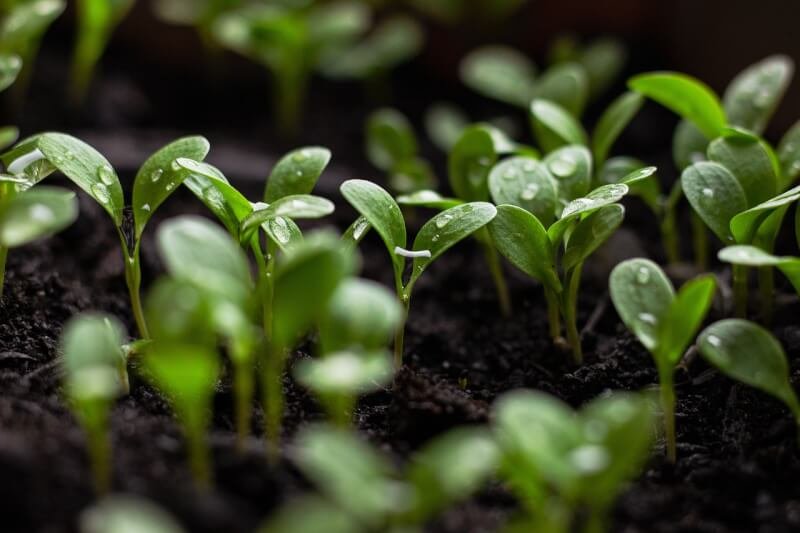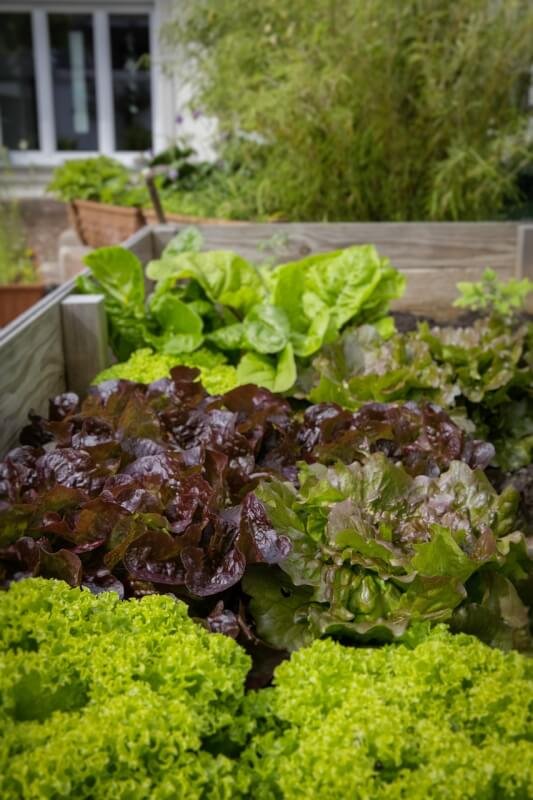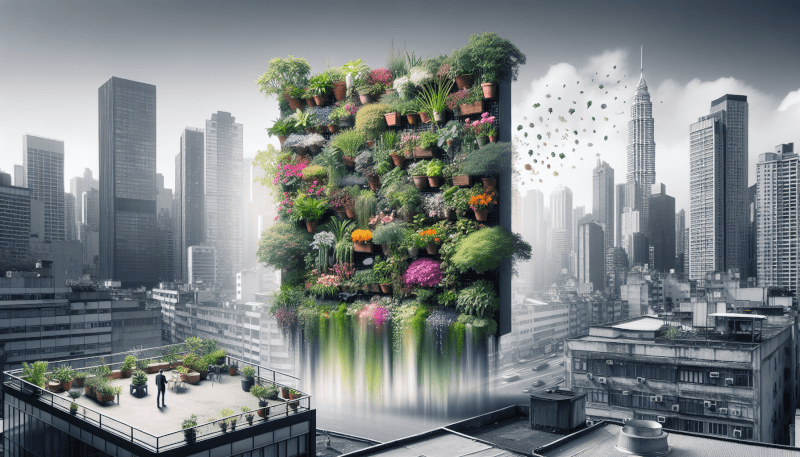Imagine transforming your small urban balcony or patio into a lush, green oasis with the help of DIY vertical garden ideas. No need to compromise on your love for gardening just because of limited space. In this article, we will explore creative and easy-to-implement strategies for urban gardening using vertical planters. From repurposing old pallets to creating a hanging plant wall, these ideas will not only beautify your space but also bring nature closer to you in an urban setting. So, get ready to dive into the world of vertical gardening and let your imagination flourish!

Choosing the Right Location
Consider the amount of sunlight
When choosing a location for your vertical garden, it’s crucial to consider the amount of sunlight it will receive. Most plants require at least six hours of direct sunlight each day to thrive. Take note of any buildings or trees that may cast shadows on your chosen spot throughout the day. If your desired location doesn’t receive enough sunlight, consider installing grow lights to supplement the natural light.
Evaluate the wind conditions
Wind can negatively impact the health of your vertical garden, so it’s important to evaluate the wind conditions in your chosen location. Strong winds can cause plants to dry out quickly and may lead to damage or even the toppling of your vertical garden structure. If your location experiences strong winds, consider planting wind-resistant plants or installing windbreaks such as trellises or fences.
Look for a sturdy surface
The surface on which you’ll be installing your vertical garden should be sturdy enough to support the weight of the plants, containers, and any additional structures. Look for surfaces such as solid walls or fences that are capable of withstanding the weight and pressure. Avoid installing your garden on weak or unstable surfaces that may compromise the integrity of the structure over time.
Assess the water source
Access to a reliable water source is essential for the health and maintenance of your vertical garden. Consider the proximity of the water source to your chosen location. It should be easily accessible and provide a sufficient amount of water for your plants’ needs. If the water source is too far away, consider installing a drip irrigation system or utilizing rainwater collection techniques to ensure your plants receive adequate hydration.
Container Options for Vertical Gardens
Hanging pots and baskets
Hanging pots and baskets are a popular choice for vertical gardens, as they are easy to install and allow for creative arrangements. These containers can be suspended from walls, railings, or even tree branches, providing a visually appealing display of cascading plants. Hanging pots and baskets are particularly well-suited for trailing plants and flowers, adding a touch of beauty and vibrancy to your vertical garden.
Wall-mounted planters
Wall-mounted planters are another versatile option for creating a vertical garden. These containers are designed to be attached directly to walls or fences, maximizing vertical space while also acting as a decorative element. Wall-mounted planters are available in various sizes and materials, allowing you to customize your vertical garden based on your preferences and the specific needs of your plants.
Vertical gardening towers
Vertical gardening towers are standalone structures that provide multiple levels of planting space. These towers are often made of durable materials such as metal or plastic and can accommodate a large number of plants. With their compact footprint, vertical gardening towers are ideal for small spaces and can be placed on patios, balconies, or even indoors. They offer a visually striking way to showcase a diverse array of plants in a limited area.
Pallet gardens
Repurposing wooden pallets as planters is a cost-effective and eco-friendly option for creating a vertical garden. Pallet gardens allow you to utilize both the vertical and horizontal space, as plants can be planted in the gaps between the pallet slats. With a bit of creativity, you can transform a simple pallet into a beautiful and functional vertical garden. Just ensure that the pallet is untreated to avoid any potential harm to your plants.

Creative Plant Selection
Herbs and spices
Growing your own herbs and spices in a vertical garden is not only convenient but also adds a delightful aroma to your living space. Herbs like basil, thyme, and rosemary flourish in vertical gardens and can be readily accessible for culinary uses. Their compact size and ability to thrive in a variety of growing conditions make them excellent choices for vertical gardens.
Flowering plants
Adding flowering plants to your vertical garden brings a splash of color and beauty to any space. Consider varieties such as petunias, marigolds, or pansies that thrive in vertical environments. Not only do these plants provide aesthetic value, but they also attract pollinators such as bees and butterflies, contributing to a thriving garden ecosystem.
Succulents and cacti
Succulents and cacti are excellent choices for vertical gardens, especially in drier climates or indoor environments. Their unique shapes and textures create an interesting visual display. These low-maintenance plants are known for their water-storing capabilities, making them well-suited to vertical gardening.
Fruit and vegetable varieties
Vertical gardens offer the opportunity to grow your own fresh fruits and vegetables, even in limited spaces. Consider vine plants such as tomatoes, cucumbers, and beans, which can be trained to grow vertically. This allows you to maximize your yield while minimizing the use of horizontal space. Some compact fruit trees, like citrus or dwarf apple trees, can also be grown in vertical gardens, adding a touch of homegrown goodness.
DIY Vertical Garden Structures
Stacked crates system
A DIY vertical garden using stacked crates is an easy and affordable option for those who are creatively inclined. Simply stack wooden crates in a secure manner, leaving space between each crate for plants to grow. Ensure proper drainage by drilling holes in the bottom of each crate. You can arrange the crates in various patterns and sizes, creating an eye-catching display of plants in your vertical garden.
PVC pipe planters
Using PVC pipes as planters is a versatile and lightweight option for vertical gardens. Cut the PVC pipes into desired lengths and drill holes along the sides for plant placement. Attach the pipes to a sturdy frame or mount them directly on a wall. This DIY method allows for a compact and organized vertical garden that can be easily customized to accommodate different plant sizes and quantities.
Shipping pallet trellis
A shipping pallet trellis is a creative way to combine vertical gardening with a trellis system for vine plants. Simply secure a wooden pallet vertically and attach supports for climbing plants to grow. The open slats of the pallet provide ample space for vines to weave through, creating a visually stunning display of foliage. This DIY technique is perfect for growing plants like cucumbers, beans, or morning glories.
Gutter garden
Repurposing gutters as planters is an innovative way to create a vertical garden with built-in drainage. Mount the gutters horizontally to a sturdy surface, ensuring a slight angle for water flow. Fill the gutters with soil and plant your chosen plants in rows. Gutter gardens are ideal for growing compact plants and herbs, and their linear design offers a sleek and modern aesthetic to any vertical garden.

Irrigation Systems for Vertical Gardens
Drip irrigation
Drip irrigation is an efficient and water-saving system for vertical gardens. It delivers small amounts of water directly to the root zone of plants, minimizing water waste through evaporation or runoff. Drip irrigation can be customized to suit the specific needs of your plants, ensuring they receive the right amount of hydration at regular intervals. This system can be easily automated with timers, making it convenient for busy gardeners.
Self-watering systems
Self-watering systems are a convenient option for vertical gardens, especially for those with limited time to dedicate to watering. These systems consist of a reservoir or water storage tank connected to the plant containers through a wicking mechanism. The plants draw water as needed, reducing the risk of over or under watering. Self-watering systems are particularly useful in areas with inconsistent rainfall or for those who frequently travel.
Vertical hydroponics
Vertical hydroponics is a soil-less method of growing plants that utilizes water-based nutrient solutions. This innovative system allows plants to be stacked vertically, maximizing space and promoting efficient water and nutrient absorption. Vertical hydroponics is ideal for growing leafy greens and herbs, as they can thrive in nutrient-rich water environments. It is a technology-driven approach that offers precise control over watering and fertilization.
Rainwater collection
Collecting rainwater is an eco-friendly way to irrigate your vertical garden while conserving water. Install a rainwater collection system, such as a barrel or cistern, to capture and store rainwater for later use. Connect the collection system to your vertical garden irrigation system to ensure a sustainable and reliable water source. Rainwater is free from chemicals found in tap water and provides an ideal natural resource for plant hydration.
Maintenance Tips for Vertical Gardens
Regular pruning and trimming
To keep your vertical garden looking neat and healthy, regular pruning and trimming are essential. Remove any dead or decaying foliage to prevent the spread of diseases and pests. Trim back overgrown plants to maintain their desired shape and promote healthy growth. Pruning and trimming also allow for better air circulation and light penetration, enhancing the overall health of your vertical garden.
Fertilizing and feeding
Because vertical gardens often have limited access to soil and nutrients, it’s important to provide regular fertilization and feeding to your plants. Choose a balanced organic fertilizer and apply it according to the specific needs of your plants. Additionally, consider incorporating slow-release fertilizers or organic compost into the soil to supply a steady source of nutrients over time. Regular fertilizing will ensure that your plants have the necessary nutrients to thrive.
Pest and disease control
Preventing and managing pests and diseases is crucial for maintaining the health of your vertical garden. Regularly inspect your plants for signs of infestation or disease, such as wilting leaves, discoloration, or unusual growth patterns. Use organic pest control methods, such as insecticidal soaps or neem oil, to combat common pests. Employ natural disease prevention techniques, such as proper spacing between plants and good airflow, to minimize the risk of diseases spreading.
Seasonal plant rotations
To keep your vertical garden looking fresh and vibrant throughout the year, consider implementing seasonal plant rotations. Different plants thrive in different seasons, so plan ahead and choose plant varieties that will flourish in each season. Rotate out plants that have finished their growing cycle or have become less visually appealing, replacing them with new plants that complement the current season. By regularly updating the plants in your vertical garden, you can enjoy a constantly changing display of colors and textures.

Vertical Garden Design Ideas
Color coordination and themes
Creating a cohesive color palette and theme for your vertical garden can greatly enhance its visual impact. Consider choosing plants with complementary colors or ones that align with a specific theme, such as a tropical oasis or a calming Zen garden. Pay attention to the textures and leaf shapes of the plants as well, as they can add depth and interest to the overall design. By carefully selecting plants that work well together, you can create a visually appealing and harmonious vertical garden.
Creating patterns and textures
Play with patterns and textures in your vertical garden to add visual interest and dimension. Arrange plants with different leaf shapes, sizes, and textures to create a captivating mosaic effect. Experiment with various planting methods, such as alternating plant heights or combining cascading and upright plants. By combining different patterns and textures, you can create a dynamic and visually striking vertical garden.
Incorporating vertical garden art
Integrate artistic elements into your vertical garden design to add a unique flair. Install garden sculptures, wall art, or hanging decorations that complement the plants and enhance the overall aesthetic. Consider incorporating structures such as trellises or frames that serve as both functional supports for climbing plants and artistic focal points. Incorporating vertical garden art allows you to personalize your space and create a one-of-a-kind vertical garden.
Mixing different plant heights
Incorporating plants of varying heights can create a visually dynamic and visually interesting vertical garden. Group taller plants at the back or center of your vertical garden to create a sense of depth and perspective. Place medium-height plants in the middle or foreground to provide a transition between the tall and trailing plants. Trailing or cascading plants can be placed at the edges or allowed to flow down from higher levels, adding a sense of movement and softening the overall look.
Maximizing Space in Small Vertical Gardens
Utilizing vertical surfaces
When space is limited, utilizing every available vertical surface is key. Hang containers from walls, fences, or railings to maximize the use of vertical space. Consider installing shelving or trellises on walls to create additional planting areas. Use hanging pocket organizers or pockets made from fabric or recycled materials to grow small plants or herbs vertically. By thinking creatively and utilizing vertical surfaces, you can make the most of a small vertical garden.
Choosing compact plant varieties
Selecting compact plant varieties is vital when working with a small vertical garden. Choose plants that naturally grow in a more upright or compact manner. Look for dwarf or miniature varieties of vegetables, herbs, and flowers that don’t require a lot of horizontal space. Compact plants not only help maximize space but also offer the convenience of easy maintenance and harvesting in small vertical gardens.
Hanging pocket organizers
Hanging pocket organizers provide an efficient vertical gardening solution for small spaces. These organizers typically have multiple pockets, each suitable for planting individual plants. Hang the organizer on a wall or fence and fill each pocket with soil and your chosen plants. Hanging pocket organizers are particularly useful for growing herbs, succulents, or small flowering plants and can be easily moved or repositioned, offering flexibility in design and space utilization.
Vertical strawberry towers
Vertical strawberry towers are a practical and space-saving option for those who enjoy growing their own sweet treats. Construct or purchase a tower designed specifically for strawberries, ensuring it has enough planting pockets or holes. Fill the tower with soil and plant strawberry seedlings in each pocket. Vertical strawberry towers not only maximize space but also elevate the strawberries, reducing the risk of pests and providing easier access for harvesting.

Repurposing Household Items for Vertical Gardens
Old shoe organizers
Repurpose old shoe organizers as vertical garden containers. Hang the shoe organizer on a wall or fence and fill each shoe pocket with soil and plants. This method is especially useful for small herbs, flowers, or trailing plants. The shoe pockets provide individual compartments for the plants and allow for easy planting and maintenance. It’s a creative and practical way to upcycle old shoe organizers and transform them into functional pieces for your vertical garden.
Empty wine bottles
Empty wine bottles can be repurposed as unique planters in a vertical garden. Cut off the bottom of each bottle and drill small drainage holes in the lid. Fill the bottles with soil and plant small plants or succulents. Arrange the wine bottle planters on a wall or fence, creating an interesting and eco-friendly display. The glass bottles add a touch of elegance and can serve as conversation starters in your vertical garden.
Unused picture frames
Unused picture frames can be transformed into stylish planters for a vertical garden. Remove the glass or backing from the frames and attach wire mesh or burlap to create a base for the plants. Fill the frame with soil and plant your chosen plants in the designated areas. Hang the framed planters on a wall or fence to create a unique and visually appealing vertical garden. This DIY method allows you to showcase your plants in an artistic and unconventional way.
Kitchen utensil holders
Repurpose kitchen utensil holders as hanging planters in your vertical garden. Many utensil holders are designed to be hung or have holes for drainage, making them perfect for planting small herbs, succulents, or other compact plants. Hang the utensil holders on a wall or fence, ensuring they receive adequate sunlight. This creative method allows you to efficiently utilize vertical space in your kitchen and incorporate plants while adding a touch of functional décor.
Benefits of DIY Vertical Gardens
Saves space in small urban areas
One of the key benefits of DIY vertical gardening is its ability to save space in small urban areas. With limited outdoor areas, vertical gardens offer a solution for those who want to enjoy gardening but have limited space. By utilizing vertical surfaces and compact plant varieties, you can create a thriving garden even in the smallest of spaces.
Adds aesthetic value to buildings
Vertical gardens have the power to transform the appearance of buildings and add aesthetic value to otherwise plain or unremarkable facades. Whether it’s a single wall or an entire building covered in flourishing plants, vertical gardens create a stunning visual impact and can turn any structure into a vibrant and inviting space.
Improves air quality and reduces noise pollution
Vertical gardens play a crucial role in improving air quality, particularly in urban areas with high pollution levels. Plants absorb carbon dioxide and release oxygen, reducing the concentration of harmful pollutants in the air. In addition, the foliage of vertical gardens can act as a natural sound barrier, helping to reduce noise pollution and creating a more peaceful environment.
Provides access to fresh home-grown produce
One of the most rewarding aspects of DIY vertical gardening is the ability to grow your own fresh produce. Vertical gardens offer the opportunity to cultivate a wide range of fruits, vegetables, and herbs, providing you with a constant supply of home-grown and pesticide-free produce. Whether it’s a handful of herbs for cooking or a bountiful harvest of your favorite vegetables, a vertical garden allows you to enjoy the satisfaction of home-grown goodness.


